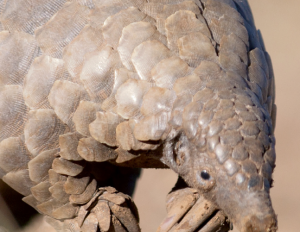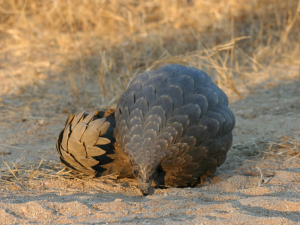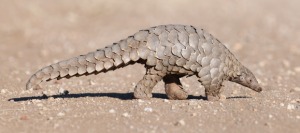Get to know this endangered armored creature.
I was doing my rounds on our office grounds last month when I heard excited chatter among my ground personnel. One of them claimed to have spotted a Balintong in the nearby shrubbery. This really piqued my interest because I had not heard the word, let alone seen the creature, for a very long time.
 Since the middle of last year, we have had an unusually number of wildlife sightings in the vicinity of our office building. El Niño is making the animals desperate enough to risk encountering humans to get food and water. Our chicken coops and tilapia nurseries on the adjacent property provide shade, abundant feed, and an unlimited water supply. It has become a magnet for any wandering animal. Despite the destruction of the animal’s habitat and their ever-decreasing numbers, I still encounter—in varying frequencies—animals that I have known since I was a little kid. I frequently see monitor lizards, herons, kingfishers, squirrels, and snakes. On rare occasions, I see musang, matala, eagles and the Blue-Naped Parrot.
Since the middle of last year, we have had an unusually number of wildlife sightings in the vicinity of our office building. El Niño is making the animals desperate enough to risk encountering humans to get food and water. Our chicken coops and tilapia nurseries on the adjacent property provide shade, abundant feed, and an unlimited water supply. It has become a magnet for any wandering animal. Despite the destruction of the animal’s habitat and their ever-decreasing numbers, I still encounter—in varying frequencies—animals that I have known since I was a little kid. I frequently see monitor lizards, herons, kingfishers, squirrels, and snakes. On rare occasions, I see musang, matala, eagles and the Blue-Naped Parrot.
Just a few months ago, I heard my staff talking about a phantom cat, which I think is a Palawan Leopard Cat. A few weeks ago, our maintenance staff stumbled upon a Musang nest within the folds of the roof insulation foam. This was followed by the discovery of a Box Turtle in one of the tilapia nurseries. It is still living there! And I saw a family of 5 waterhens that probably has a nest nearby. We also spotted a monitor lizard basking in a puddle near the fish nursery. If the sighting is for real, a Balintong is a precious find indeed. The Balintong is known as the ‘Pangolin’ in English.
Curiously, the name ‘Pangolin’ was derived from the Malaysian name of the animal, which is ‘Pengguling’. Both the Filipino term ‘balintong’ and the Malaysian term ‘guling’ mean “rolling over,” which is what the Pangolin does when it feels threatened: it rolls into a tight, armored ball. I had several encounters with them during my childhood years. Most of them were in Brooke’s Point, my mother’s hometown.
Back then, Brooke’s Point was only accessible from Puerto Princesa City through 200 kilometers or 8 hours of rocky road and wooden plank bridges. Unfortunately, most of these encounters involved watching the mountain tribesmen showing off their catch before bringing them home for cooking.
Naturally Graceful
 The Balintong is truly a unique animal in every way, and this makes my job of describing them truly challenging. Perhaps two of its most unique traits are that it is the only mammal that is covered with scales from head to toe, and that it feeds exclusively on insects. The top two favorites on its menu are ants and termites. For this reason, they are also called “scaly anteaters” and are very hard to rear in captivity.
The Balintong is truly a unique animal in every way, and this makes my job of describing them truly challenging. Perhaps two of its most unique traits are that it is the only mammal that is covered with scales from head to toe, and that it feeds exclusively on insects. The top two favorites on its menu are ants and termites. For this reason, they are also called “scaly anteaters” and are very hard to rear in captivity.
Physically, a Balintong looks somewhat like the armadillo, especially the shape of the head. But instead of the wide armored body of the armadillo, imagine a more slender and streamlined body covered with big scales. In addition, the armadillo looks like something that came out of an assembly plant, albeit a head and tail were haphazardly attached to a drum-like body.
In contrast, the small head of a Balintong gracefully curves into a wide body that curves back again into a long tail. The sturdy tail of the Pangolin helps it climb trees; it uses the tail to cling for support while it dismantles an ant or termite nest up above the forest floor. Its long, sharp claws help it dig up termite mounds on the ground, and its long sticky tongue can work its way through small openings to scoop out insects; the insects also stick to its tongue.
Its scales, which are made up of material similar to those that comprise our fingernails, gives it the armor it needs against predators. In the wild, the Pangolin only needs to curl up to defend itself. The hungry wild dog or big cat will soon give up on trying to pry the Pangolin open and leave it alone. Unfortunately, this strategy does not work against humans. When it comes to behavior, the Pangolin is a very shy and gentle creature. With my own experience handling a wild Pangolin, it never used its sharp claws to slash at me. I was wary of those claws at first. They are very hard and sturdy (later on, I would learn the hard way what they were for).
It does not have teeth either. All the times I tried to approach this creature, it never tried to do anything threatening or fight back. It just either walked away or curled up into a hard ball. My latest encounter with this animal was about eight years ago. My brother Paul chanced upon two men carrying an adult Balintong in a sack. The men were taking it home to eat it for dinner. Paul tried to talk them out of it. After a brief discussion, he was able to convince them to sell it to him for a few hundred pesos.
When he took it home, everybody was in a quandary on what to do. Naturally, everybody was in agreement that it must be turned over to the PWRCC. But how were we to keep it in the meantime? Little did we know that the gentle fellow would keep us busy well into the night.
A Clawed Surprise
 Paul brought home his rescued Balintong in the mid-afternoon. Everybody was surprised and excited to see this wonderful creature. At first, we tried our best to get it something to eat. We collected as many ants as we could, but it would not eat them. We heard from old folks that the Balintong would not eat dead ants, so we brought it live ants. Soon, the ants had all crawled away.
Paul brought home his rescued Balintong in the mid-afternoon. Everybody was surprised and excited to see this wonderful creature. At first, we tried our best to get it something to eat. We collected as many ants as we could, but it would not eat them. We heard from old folks that the Balintong would not eat dead ants, so we brought it live ants. Soon, the ants had all crawled away.
We surmised that we did not bring enough ants to catch its interest and we were not able to “serve” them in a manner that a wild Balintong would prefer: in a hive of rock and dirt. We realized that we had a bigger task at hand: how to restrain it. The stress of being captured and the excited humans around it caused it to become restless, so it was actively and continuously trying to get away.
The problem was that the animal is very hard, very strong, and its scales and claws are very sharp. I imagine that it is the animal world’s version of the tank. It is covered in armor and its legs and tail are able to move things much heavier than its own weight.
Its claws and scales, while not intended to harm anyone, can easily cut skin. Just holding it on its body while it is struggling to get away resulted in cuts on my hands. Its claws, while trying to pry my hands off its body, also gave me cuts. Our immediate concern was how to subdue the animal without causing it any harm, so we tried a dog cage.
Thing is, the Balintong is able to flatten its body and squeeze out of tight openings. With holes that are too small for it to fully squeeze through, the problem is that its scales face backwards, so the Balintong cannot move backwards once it is stuck as its scales will snag. This causes severe stress to the animal and can lead to serious injuries.
By sunset, we were able to tie up the Pangolin with a nylon rope. After a few minutes, we noticed that the rope was moving upwards. When we went out to check, we were flabbergasted to see the Pangolin climbing up our wall. Its sharp claws could cling to the pebbled wall with ease. I was able to get hold of the tip of its tail before it completely got out of reach. But the scales were painful to hold on to. I tried shaking it off the wall but it would not let go.
To my great surprise, it would not come off the wall even when I applied my full weight. The Pangolin and I were at a stalemate. Fortunately, my quick-thinking brother went to get a wooden pole. He lifted its claws off the wall one at a time and we were able to recapture it. Seeing that we did not have any other choice, we decided to confine it in one of our toilets. This, however, is not the end of the story.
Toilet Tracking
 After our dinner and before going to sleep, we decided to check on our prisoner. To our horror, there was no Pangolin in the toilet. We couldn’t figure out how it escaped as there was no exit aside from the door. A mysterious creature, indeed! Everybody helped out in searching the entire house.
After our dinner and before going to sleep, we decided to check on our prisoner. To our horror, there was no Pangolin in the toilet. We couldn’t figure out how it escaped as there was no exit aside from the door. A mysterious creature, indeed! Everybody helped out in searching the entire house.
Finally, somebody had the presence of mind to bring a flashlight and double check the toilet. It turned out that the Pangolin was there all along, curled into a ball right inside the toilet bowl. Due to the dim light of the toilet, the round shape of the Pangolin, and its shiny scales, it turned itself almost invisible inside the toilet bowl.
The next morning, I drove the Balintong 12 kilometers outside the city to PWRCC. According to the staff I talked to, they would not keep it there either. They will just give it a thorough checkup and they will release it back to the wild as soon as possible.
Turns out, the PWRCC also had the same difficulty we experienced in caging and feeding the animal! This experience gave me a great deal of appreciation for this creature. I was able to see its unique beauty up close and test its strength with my own hands.
Why We Need to Save This ‘Armored’ Creature
 I was very intrigued by the possible existence of the Balintong here in my backyard because they have become so rare nowadays. In fact, many of my office personnel do not even know what a Balintong is. I have suddenly become curious as to why I have not seen or heard of this animal for the last eight years. My brief research gave me a chilling answer.
I was very intrigued by the possible existence of the Balintong here in my backyard because they have become so rare nowadays. In fact, many of my office personnel do not even know what a Balintong is. I have suddenly become curious as to why I have not seen or heard of this animal for the last eight years. My brief research gave me a chilling answer.
The Pangolin is now the most hunted and most trafficked wildlife in the world. This is because people in Asia believe that their meat improves vitality and their scales can cure several ailments. And, unlike the high profile endangered animals such as elephants, crocodiles and the big cats, people are just not aware of how endangered the Pangolin is.
The laws for its protection and the coordination among governments for this effort are still weak. To make matters worse, Pangolin meat and scales are very easy to transport and smuggle. For these reasons, the Pangolin went from protected to threatened to endangered and finally, to critically endangered very quickly in just the last three decades. In fact, the Pangolin was classified as critically endangered by the Palawan Council for Sustainable Development (PCSD) only last year.
Intercepted shipments of Pangolin (frozen, live, or dead) can involve hundreds or thousands of animals per shipment. For a creature that reproduces at the rate of 1 or 2 pups in a year, simple math tells us that the Pangolin can be wiped out any time soon. This is very perplexing for me. I grew up seeing and knowing that there were a lot of Pangolins.
I realized all of a sudden that there are not any more of them. I hope that we can work together with the different branches of the government to stop the illegal trapping and trading of our Pangolin. We only have one type of Pangolin in the Philippines: the Philippine Pangolin or Palawan Pangolin, and they can only be found in Palawan. When its population drops to the level where it can no longer replenish itself, then we are going to see the extinction of a truly wonderful animal.
I now have doubts that my ground staff really saw a Balintong in the nearby woods. Maybe was just a figment of the imagination for a person such as myself, who grew up being familiar with this creature. We realize all of a sudden that this childhood acquaintance no longer manifests itself. And we are left to our own thoughts, chasing memories of something so beautiful and yet so hard to vividly remember.
This appeared in Animal Scene’s May 2016 issue.






